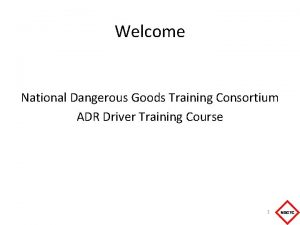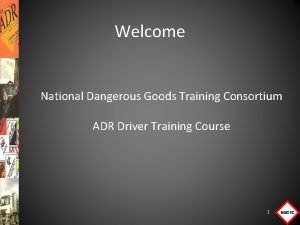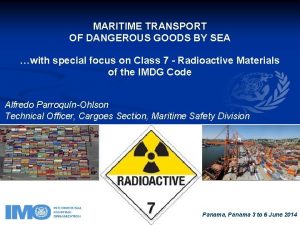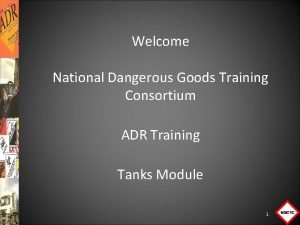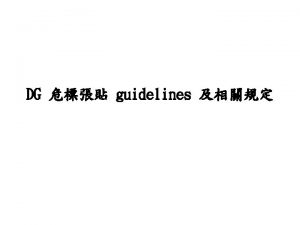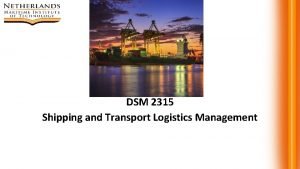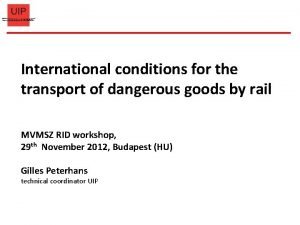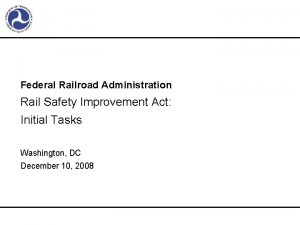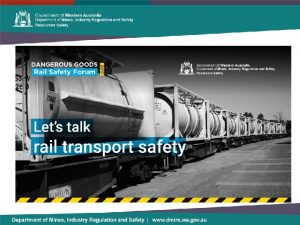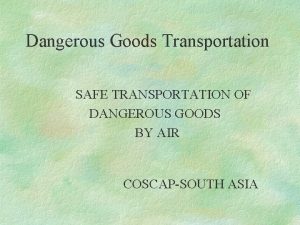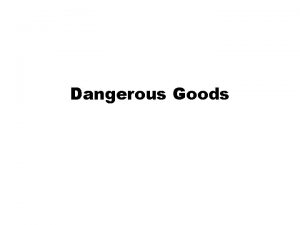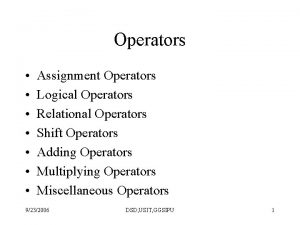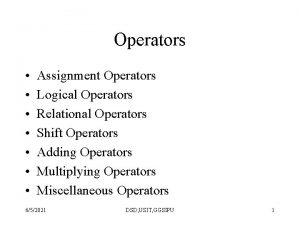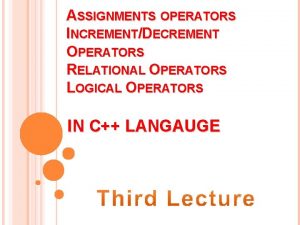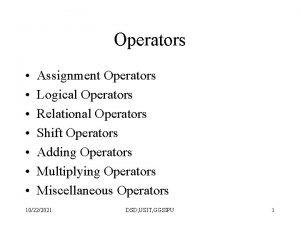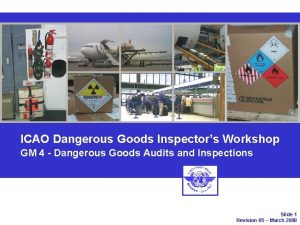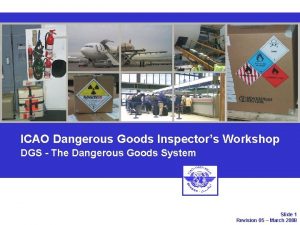Dangerous Goods Rail Safety Forum An Operators Perspective













- Slides: 13


Dangerous Goods Rail Safety Forum An Operator’s Perspective Paul Garvey Aurizon Safety Partner – Bulk South West

Introduction To provide an overview of an Operator’s perspective in relation to transporting Dangerous Goods by Rail, including: • The importance of external relationships – regulators, consultants, DFES, AMSA • The importance of working with Customers – when providing additional value other than transport • Transporting Dangerous Goods – Compliance • Dangerous Goods In-Transit – what does this mean? • Segregation on Rail • The importance of training - employees 3

About Aurizon is Australia's largest rail freight operator by volume. • The company transports more than 250 million tonnes of Australian commodities per annum. • 3. 7 million tonnes are Dangerous Goods (105 active DG accounts across 13 classes) • Operates approx. 500 locomotives and 13000 wagons. The company also owns one of the world’s largest coal rail networks, linking approx. 50 mines with three major ports in Queensland. Four major product lines 1. Network – Queensland only 2. Coal - Primarily Queensland with operations in Western Australia 3. Bulk – Primarily in Western Australia and Queensland (80% of DG) 4. Intermodal 4

The importance of external relationships • Maintain a good relationship with your DG consultant (they may not charge you for everything!) › You should have a consultant for any DG licence related matters in WA, not so in all other states however • Keep your regulator updated with what you do › Introduce them to your operation, they are there to help ensure you are operating safely. Work with them. › Avoids any surprises in forthcoming licence audits • Suppliers › More often than not they have experience with other related rail companies › Technical expertise • DFES › One of the most important relationships › Ensures familiarity with your operation in the event of an emergency › Certain licence conditions require a specific emergency plan to be developed with DFES (FES-ERG) • Rail Interface › Important you have a clear and auditable Safety Interface Agreement (SIA) with the third party siding owner 5

Customers • You are transporting their product • They can provide key training for ensuring you have the correct safety systems in place • Refer to the ADG Code and SDS for the method of storing, handling or transporting the product • Perform compliance checks against any applicable Australian Standards • Aurizon Dangerous Goods Customers service providing: › Load and unload Caustic Soda to and from Rail Wagons › › – Ongoing joint working process for operating at the location – Focus on removal of all potentials for Caustic Soda exposure – Leadership Efficiency Tests Transport and Shunting of Anhydrous Ammonia (AA) – Transport of AA from Kwinana to Malcolm – One of the most hazardous products (high consequence, low likelihood) – Provision of gas monitors whilst shunting at Malcolm Transport and Storage of Sodium Cyanide – Transport from Kwinana to Kalgoorlie – Risk rating again – high consequence, low likelihood 6

Transporting dangerous goods - compliance • Transporting Dangerous Goods is not the same as Transporting General Freight! • It is not quite the same set of rules for Road Transport and Rail transport! E. g. Chapter 12. 1 Safety Equipment For Road Vehicles…not Rail • ADG 7 provides the requirements for transporting dangerous goods by road and rail. › Current version ADG 7. 4, ADG 7. 5 is compulsory from March 2018 › Does not change too frequently › Heavily focused around Road Transport • Transporting DG destined for transport by Marine? › Australian Maritime Safety Authority (AMSA) – implement the International Maritime Organisation (IMO) regulations › Refer to IMDG Code – Current Amendment 38 -16 › Can change every 2 years › Very similar to the ADG Code › Also have Marine Orders to adhere to e. g. – Marine Order 41 – Carriage of dangerous goods – Marine Order 44 – Safe Containers 7

Dangerous goods in transit What does this mean? According to Dangerous Goods safety (Storage and Handling of Non Explosives) Regulations 2007, dangerous goods in transit means dangerous goods that — (a) are supplied to a dangerous goods site in containers that are not opened at the site; and (b) are not used at the site; and (c) are kept at the site for a period of not more than 5 consecutive days; However, the crucial question is: ‘do you have the capability to deal with the product in the event of an emergency at any point in time’? 8

Segregation Aurizon has interpreted the requirements of ADG and legislation and developed this Matrix for DG> 9

Additional segregation rules • Passenger Trains – Dangerous Goods must not be taken on board a passenger train and a there are restrictions to the volume and placement of wagons designed to carry dangerous goods on a train. Refer to ADG code, section 9. 2. 4. 7 • Locomotive separation – Dangerous Goods must not be transported in the nearest transport unit to the locomotive, and last wagon on train, however: • Except for transport in a rail tank wagon (ADG 7. 5, Additional Rail Provisions 9. 2. 4. 1) • Piercing hazards – Dangerous Goods must be separated by at least 2 intervening load platforms which are transporting loads with a significant piercing hazard • Double stacking – restrictions apply. Refer to 9. 2. 4. 8 10

Risk register A critical element for your operation for Dangerous Goods • Ensure you have identified all the potential failures (view it as an HAZOP study) • Explore further opportunities with your customers to pre-determine incident response accountabilities • Review the register following each Incident to ensure new learnings are adopted by the control systems • Do your controls include auditing of customer maintained equipment? • Consider Risk Profiling – High Consequence Low Likelihood • Factor in other activities in your operational areas along with temporary storage of containers, they still need to adhere to segregation prior to loading on to a train 11

Segregation – test your knowledge 5. 1 Can we transport this train? 6. 1 2. 3 4. 3 Can we transport this train? 5. 1 4. 1 12

13
 Convenience goods shopping goods specialty goods
Convenience goods shopping goods specialty goods Public goods vs private goods
Public goods vs private goods Positive consumption externality
Positive consumption externality Publik goods
Publik goods Dangerous goods consortium
Dangerous goods consortium Dangerous goods consortium
Dangerous goods consortium United nations convention on the carriage of goods by sea
United nations convention on the carriage of goods by sea Dangerous goods consortium
Dangerous goods consortium Lq dangerous goods
Lq dangerous goods Imdg classes
Imdg classes Definition of dangerous goods
Definition of dangerous goods Rail safety improvement act of 2008
Rail safety improvement act of 2008 European rail safety climate survey
European rail safety climate survey One point perspective staircase
One point perspective staircase




